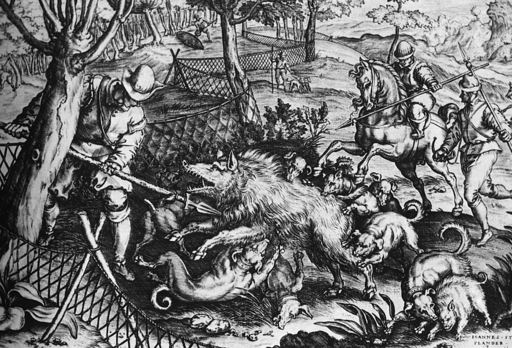
Pig dog.
The term is most decidedly not a compliment in our house. It is saved for those occasions when one of our dogs does something disgusting, and it is usually said with tone of disgust. It’s been our observation over the years that no “pig dog” of ours has ever shown remorse or even shame. Isn’t that just like a pig?
We segue to a similar term, “saupacker,” a literal description that translated from German meant sow dog, sow-hunter, or boarfinder. These “sow packers” typically accompanied hunters on horseback, and were used with great success to hunt wild boar well into the late 1800s. These hunts were so dangerous that dogs were outfitted with hunting dog armor for protection from the lethal tusks of wild boar.
Dogs of different sizes made up a typical pack, the size dictating the dog’s job. Small, agile, and fine nosed scent hounds were used to find the boar, and then bark at it. Larger dogs drove it out of its hiding place, and even larger, heavier dogs grabbed hold of a boar and held it down until the hunter dispatched it with a boar feather which also lead to the term, saupacker.
Today, these dogs are known as Great Danes, but there have been few other breeds known by so many different names over time, something we discussed in an earlier post that you can read below:
The word, saupacker, still appears in the Great Dane’s FCI standard under the historical summary. It also appears somewhere else, and this is where it gets puzzling, at least to us.
The Alianz Canine Worldwide is an organization with members on five continents. According to its website, it is an “International Cynological Organization that coordinates the national organizations that issue registration documents for canine breeds (pedigree).” [It] “promotes collaboration with dog sports organizations, canine rescue work groups, dog shows, courses, international training, etc….”
We know next to nothing about the organization beyond what you’ve just read (and if one of our readers has more knowledge, we’d like to hear from you). We note that on their page of accepted breeds, the Great Dane is listed, but so is the Saupacker which the ACW recognized on June 18, 2016. Clearly, this suggests two different breeds.
But is the Saupacker a breed?
We ask the rhetorical question because we came across one breeder’s site which stated that certain breeds (German Mastiff, Rottweiler, Cane Corso, Mastiff, Dogue de Bordeaux, Bullmastiff and Broholmer) might be represented with a maximum of 62.5% of each breed. Another site explained that the Saupacker “is a big, strong dog, his courage is incomparable should its people or its territory be in danger,” and that the stated goal is to “breed a large, healthy and above all long-lived Molosser!”
The more we looked, the more we found traits of a Saupacker, but not what it is genetically. We’ve reached out to some of the Saupacker folks to learn what exactly their dogs are, and we promise to report back when we learn more.
For now, we conclude with an explanation of our subject title. For a time, we lived in the southeastern United States where we were introduced to “barbecue.” When we asked, “barbecued what?” we were met with peals of laughter. To this day, we still don’t know what we were eating, only that it was barbecued something. The Saupacker is a large molosser type dog, but what, exactly, it is, we don’t yet know. The barbecue from all those years ago may remain a mystery, but we aim to learn more about the genetics of the Saupacker in the interest of education.
Image: 16th century engraving of a boar hunt shared from the public domain
